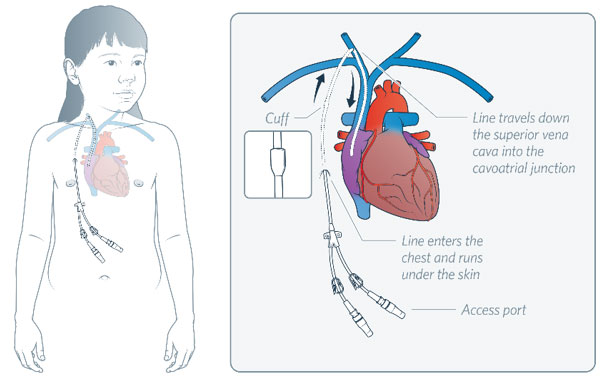What is a Central Venous Access Device (CVAD)?
A CVAD is a thin tube that is inserted into a vein, usually in the neck. One end of the CVAD can be seen on the outside of your child’s body, with the other end sitting in one of the major vessels near the heart.
Why does my child need a CVAD and how long can it stay in for?
A CVAD is usually required when medication needs to be given for more than two weeks. A CVAD reduces the amount of needles that your child needs as it can also be used for blood tests. Depending on your child’s treatment, the CVAD may need to stay in place for months to years.
Is there more than one type of CVAD?
There are many types of CVADs. Depending on your child’s medical needs, the team will choose the best CVAD for them.
TC-CICC
A tunnelled cuffed centrally inserted central catheter (TC-CICC) is a type of CVAD that is inserted into a vein in the neck and exits out at the chest. A small section of the CVAD sits underneath the skin and is ‘tunnelled’ through the chest wall. Sometimes other names will be used for this type of CVAD, ask your health care professional what your child’s device is called.
TC-CICCs also have a small ‘cuff’ that lies underneath the skin. Over time the cuff will stick to the tissue underneath the skin. This usually takes about four to six weeks to occur. The cuff helps to prevent infection and reduces the risk of the CVAD falling out.
The dressing covering the CVAD and access ports are changed once a week. This can be done either in the hospital or in your home.
CVAD: Tunnelled Cuffed - Centrally Inserted Central Catheter (TC-CICC)

Common CVAD complications
One of the most common problems that happens with CVADs is a blockage inside the tube. This is usually caused by a small blood clot. Most of the time this can be fixed with medication that removes the clot. It takes between two to four hours for this medication to work and it needs to be given in hospital.
Your child’s CVAD is well secured, however, it is possible for them to fall out or be pulled out accidentally.
The team caring for your child’s CVAD will use a cleaning solution to keep the skin and access ports clean. However, germs can still get into the CVAD which may lead to an infection.
Care at home – preventing infection
It is important to keep giving your child a bath or shower as this stops germs on the skin. When bathing your child, make sure the dressing and tube remains clean and dry.
- If your child has a bath, you can use a piece of tape to hold the tube your child’s chest.
- If your child has a shower, any clean plastic covering can be used to help protect the dressing and tube from water, such as a plastic bag or cling film with tape securing the edges.
- Your child cannot go swimming while they have a CVAD in place.
- Make sure the end of the CVAD is kept away from nappies.
- Keep scissors or any other sharp objects away from your child’s CVAD.
When to seek medical attention
- If you are worried about your child’s condition, call an ambulance.
- Seek medical attention if you notice:
- Any redness or swelling underneath the dressing or if the dressing is dirty.
- If any of the access ports or clamps have come undone.
- If the CVAD has started to or completely come out.
- Chills or fever.
- If you have any worries about your child’s condition.
Emergency management
If your child’s CVAD falls out in the home or at school, place pressure where the CVAD comes out of the chest and present to the hospital or call an ambulance.
Key points to remember
- Make sure your child has a bath or a shower once a day and always wash your hands before and after touching the CVAD.
- Keep sharp objects away from your child’s CVAD.
- Seek medical attention, present to the emergency department, or call an ambulance if you are worried about your child’s condition.
For more information
Common questions our doctors get asked
Can the CVAD get wet?
Your child cannot go swimming while they have a CVAD in place. It is important to keep the CVAD dressing clean and dry to prevent infection. Small splashes of water should be wiped off with a clean towel or cloth.
Can my child play sport?
Your child should not play any contact sport when the CVAD is in place as this may damage the device. Talk to your health care professional about what activities are safe for your child to do.
Developed by The Royal Children's Hospital CVAD Committee. We acknowledge the input of RCH consumers and carers.
Created December 2020.
Kids Health Info is supported by The Royal Children’s Hospital Foundation. To donate, visit www.rchfoundation.org.au.